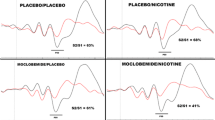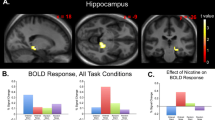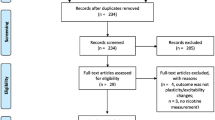Abstract
Rationale
Tobacco use is linked to cerebral atrophy and reduced cognitive performance in later life. However, smoking-related long-term effects on brain function remain largely uncertain. Previous studies suggest that nicotine affects serotonergic signaling, and the intensity dependence (alias loudness dependence) of the auditory evoked N1-P2 potential has been proposed as a marker of serotonergic neurotransmission.
Objective
In the present study, we assesed the effects of chronic smoking on amplitude and intensity dependence of the auditory evoked N1-P2 potential.
Methods
Subjects underwent a 15-min intensity dependence of auditory evoked potentials (IAEP) paradigm. From N = 1739 eligible subjects (40–79 years), we systematically matched current smokers, ex-smokers, and never-smokers by sex, age, alcohol and caffeine consumption, and socioeconomic status. Between-group differences and potential dose-dependencies were evaluated.
Results
Analyses revealed higher N1-P2 amplitudes and intensity dependencies in never-smokers relative to ex- and current smokers, with ex-smokers exhibiting intermediate intensity dependencies. Moreover, we observed pack years and number of cigarettes consumed per day to be inversely correlated with amplitudes in current smokers.
Conclusions
According to the IAEP serotonin hypothesis, our results suggest serotonin activity to be highest in current smokers, intermediate in ex-smokers, and lowest in never-smokers. To our knowledge, the present study is the first providing evidence for a dose-dependent reduction in N1-P2 amplitudes. Further, we extend prior research by showing reduced amplitudes and intensity dependencies in ex-smokers even 25 years, on average, after cessation. While we can rule out several smoking-related confounders to bias observed associations, causal inferences remain to be established by future longitudinal studies.


Similar content being viewed by others
References
Åkerstedt T, Gillberg M (1990) Subjective and objective sleepiness in the active individual. Int J Neurosci 52(1-2):29–37. doi:10.3109/00207459008994241
Allender S, Balakrishnan R, Scarborough P, Webster P, Rayner M (2009) The burden of smoking-related ill health in the UK. Tob Control 18(4):262–267. doi:10.1136/tc.2008.026294
Almeida OP, Garrido GJ, Lautenschlager NT, Hulse GK, Jamrozik K, Flicker L (2008) Smoking is associated with reduced cortical regional gray matter density in brain regions associated with incipient Alzheimer disease. Am J Geriatr Psychiatry 16(1):92–98. doi:10.1097/JGP.0b013e318157cad2
Benwell ME, Balfour DJ, Anderson JM (1990) Smoking-associated changes in the serotonergic systems of discrete regions of human brain. Psychopharmacology (Berl) 102(1):68–72
Chang RC, Ho Y, Wong S, Gentleman SM, Ng H (2014) Neuropathology of cigarette smoking. Acta Neuropathol 127(1):53–69. doi:10.1007/s00401-013-1210-x
Chauveau N, Franceries X, Doyon B, Rigaud B, Morucci JP, Celsis P (2004) Effects of skull thickness, anisotropy, and inhomogeneity on forward EEG/ERP computations using a spherical three-dimensional resistor mesh model. Hum Brain Mapp 21(2):86–97. doi:10.1002/hbm.10152
Colrain IM, Campbell KB (2007) The use of evoked potentials in sleep research. Sleep Med Rev 11(4):277–293. doi:10.1016/j.smrv.2007.05.001
Crowley KE, Colrain IM (2004) A review of the evidence for P2 being an independent component process: age, sleep and modality. Clin Neurophysiol 115(4):732–744. doi:10.1016/j.clinph.2003.11.021
Daumann J, Till B, Fischermann T, Rezk M, Gouzoulis-Mayfrank E (2006) Intensity dependence of auditory evoked dipole source activity in polydrug ecstasy users: evidence from an 18 months longitudinal study. J Psychopharmacol (Oxford) 20(2):236–244. doi:10.1177/0269881106059733
Durazzo TC, Insel PS, Weiner MW (2012) Greater regional brain atrophy rate in healthy elderly subjects with a history of cigarette smoking. Alzheimers Dement 8(6):513–519. doi:10.1016/j.jalz.2011.10.006
Durazzo TC, Meyerhoff DJ, Murray DE (2015) Comparison of regional brain perfusion levels in chronically smoking and non-smoking adults. Int J Environ Res Public Health 12(7):8198–8213. doi:10.3390/ijerph120708198
Edgar JC, Hunter MA, Huang M, Smith AK, Chen Y, Sadek J, Lu BY, Miller GA, Cañive JM (2012) Temporal and frontal cortical thickness associations with M100 auditory activity and attention in healthy controls and individuals with schizophrenia. Schizophr Res 140(1-3):250–257. doi:10.1016/j.schres.2012.06.009
Ehlers CL, Wall TL, Chaplin RI (1991) Long latency event-related potentials in rats: effects of dopaminergic and serotonergic depletions. Pharmacol Biochem Behav 38(4):789–793
Evatt DP, Kassel JD (2010) Smoking, arousal, and affect: the role of anxiety sensitivity. J Anxiety Disord 24(1):114–123. doi:10.1016/j.janxdis.2009.09.006
Fritz H, Wittfeld K, Schmidt CO, Domin M, Grabe HJ, Hegenscheid K, Hosten N, Lotze M (2014) Current smoking and reduced gray matter volume—a voxel-based morphometry study. Neuropsychopharmacology 39(11):2594–2600. doi:10.1038/npp.2014.112
Gallinat J, Bottlender R, Juckel G, Munke-Puchner A, Stotz G, Kuss HJ, Mavrogiorgou P, Hegerl U (2000) The loudness dependency of the auditory evoked N1/P2-component as a predictor of the acute SSRI response in depression. Psychopharmacology (Berl) 148(4):404–411
Gallinat J, Kunz D, Lang UE, Kalus P, Juckel G, Eggers J, Mahlberg R, Staedtgen M, Wernicke C, Rommelspacher H, Smolka MN (2005) Serotonergic effects of smoking are independent from the human serotonin transporter gene promoter polymorphism: evidence from auditory cortical stimulus processing. Pharmacopsychiatry 38(4):158–160. doi:10.1055/s-2005-871237
Hedges D, Bennett DP (2014) Cigarette smoking and p300 amplitude in adults: a systematic review. Nicotine Tob Res 16(9):1157–1166. doi:10.1093/ntr/ntu083
Hegerl U, Gallinat J, Juckel G (2001) Event-related potentials: do they reflect central serotonergic neurotransmission and do they predict clinical response to serotonin agonists? J Affect Disord 62(1-2):93–100
Hegerl U, Hensch T (2014) The vigilance regulation model of affective disorders and ADHD. Neurosci Biobehav Rev 44:45–57. doi:10.1016/j.neubiorev.2012.10.008
Hegerl U, Juckel G (1993) Intensity dependence of auditory evoked potentials as an indicator of central serotonergic neurotransmission: a new hypothesis. Biol Psychiatry 33(3):173–187. doi:10.1016/0006-3223(93)90137-3
Hensch T, Herold U, Brocke B (2007) An electrophysiological endophenotype of hypomanic and hyperthymic personality. J Affect Disord 101(1-3):13–26. doi:10.1016/j.jad.2006.11.018
Hensch T, Herold U, Diers K, Armbruster D, Brocke B (2008) Reliability of intensity dependence of auditory-evoked potentials. Clin Neurophysiol 119(1):224–236. doi:10.1016/j.clinph.2007.09.127
Hensch T, Wargelius H, Herold U, Lesch K, Oreland L, Brocke B (2006) Further evidence for an association of 5-HTTLPR with intensity dependence of auditory-evoked potentials. Neuropsychopharmacology 31(9):2047–2054. doi:10.1038/sj.npp.1301020
Hernandez-Lopez S, Garduño J, Mihailescu S (2013) Nicotinic modulation of serotonergic activity in the dorsal raphe nucleus. Rev Neurosci 24(5):455–469. doi:10.1515/revneuro-2013-0012
Huang J, Sander C, Jawinski P, Ulke C, Spada J, Hegerl U, Hensch T (2015) Test-retest reliability of brain arousal regulation as assessed with VIGALL 2.0. Neuropsychiatr Electrophysiol 1(1):263. doi:10.1186/s40810-015-0013-9
Iacono WG, Carlson SR, Malone SM, McGue M (2002) P3 event-related potential amplitude and the risk for disinhibitory disorders in adolescent boys. Arch Gen Psychiatry 59(8):750–757
Jawinski P, Sander C, Mauche N, Spada J, Huang J, Schmidt A, Häntzsch M, Burkhardt R, Scholz M, Hegerl U, Hensch T (2015) Brain arousal regulation in carriers of bipolar disorder risk alleles. Neuropsychobiology 72(2):65–73. doi:10.1159/000437438
Juckel G (2015) Serotonin: from sensory processing to schizophrenia using an electrophysiological method. Behav Brain Res 277:121–124. doi:10.1016/j.bbr.2014.05.042
Juckel G, Hegerl U, Molnár M, Csépe V, Karmos G (1999) Auditory evoked potentials reflect serotonergic neuronal activity—a study in behaving cats administered drugs acting on 5-HT1A autoreceptors in the dorsal raphe nucleus. Neuropsychopharmacology 21(6):710–716. doi:10.1016/S0893-133X(99)00074-3
Juckel G, Mavrogiorgou P, Bredemeier S, Gallinat J, Frodl T, Schulz C, Möller H, Hegerl U (2004) Loudness dependence of primary auditory-cortex-evoked activity as predictor of therapeutic outcome to prophylactic lithium treatment in affective disorders—a retrospective study. Pharmacopsychiatry 37(2):46–51. doi:10.1055/s-2004-815524
Juckel G, Molnár M, Hegerl U, Csépe V, Karmos G (1997) Auditory-evoked potentials as indicator of brain serotonergic activity—first evidence in behaving cats. Biol Psychiatry 41(12):1181–1195
Juckel G, Pogarell O, Augustin H, Mulert C, Müller-Siecheneder F, Frodl T, Mavrogiorgou P, Hegerl U (2007) Differential prediction of first clinical response to serotonergic and noradrenergic antidepressants using the loudness dependence of auditory evoked potentials in patients with major depressive disorder. J Clin Psychiatry 68(8):1206–1212
Karama S, Ducharme S, Corley J, Chouinard-Decorte F, Starr JM, Wardlaw JM, Bastin ME, Deary IJ (2015) Cigarette smoking and thinning of the brain’s cortex. Mol Psychiatry 20(6):778–785. doi:10.1038/mp.2014.187
Lampert T, Kroll L, Müters S, Stolzenberg H (2013) Measurement of socioeconomic status in the German Health Interview and Examination Survey for Adults (DEGS1). Bundesgesundheitsblatt Gesundheitsforschung Gesundheitsschutz 56(5-6):631–636. doi:10.1007/s00103-012-1663-4
Lee TW, Yu YW, Chen TJ, Tsai SJ (2005) Loudness dependence of the auditory evoked potential and response to antidepressants in Chinese patients with major depression. J Psychiatry Neurosci 30(3):202–205
Linka T, Müller BW, Bender S, Sartory G (2004) The intensity dependence of the auditory evoked N1 component as a predictor of response to citalopram treatment in patients with major depression. Neurosci Lett 367(3):375–378. doi:10.1016/j.neulet.2004.06.038
Linka T, Müller BW, Bender S, Sartory G, Gastpar M (2005) The intensity dependence of auditory evoked ERP components predicts responsiveness to reboxetine treatment in major depression. Pharmacopsychiatry 38(3):139–143. doi:10.1055/s-2005-864126
Loeffler M, Engel C, Ahnert P, Alfermann D, Arelin K, Baber R, Beutner F, Binder H, Brähler E, Burkhardt R, Ceglarek U, Enzenbach C, Fuchs M, Glaesmer H, Girlich F, Hagendorff A, Häntzsch M, Hegerl U, Henger S, Hensch T, Hinz A, Holzendorf V, Husser D, Kersting A, Kiel A, Kirsten T, Kratzsch J, Krohn K, Luck T, Melzer S, Netto J, Nüchter M, Raschpichler M, Rauscher FG, Riedel-Heller SG, Sander C, Scholz M, Schönknecht P, Schroeter ML, Simon J, Speer R, Stäker J, Stein R, Stöbel-Richter Y, Stumvoll M, Tarnok A, Teren A, Teupser D, Then FS, Tönjes A, Treudler R, Villringer A, Weissgerber A, Wiedemann P, Zachariae S, Wirkner K, Thiery J (2015) The LIFE-Adult-Study: objectives and design of a population-based cohort study with 10,000 deeply phenotyped adults in Germany. BMC Public Health 15(1):691. doi:10.1186/s12889-015-1983-z
Malone KM, Waternaux C, Haas GL, Cooper TB, Li S, Mann JJ (2003) Cigarette smoking, suicidal behavior, and serotonin function in major psychiatric disorders. Am J Psychiatry 160(4):773–779
Manjarrez G, Hernandez E, Robles A, Hernandez J (2005) N1/P2 component of auditory evoked potential reflect changes of the brain serotonin biosynthesis in rats. Nutr Neurosci 8(4):213–218. doi:10.1080/10284150500170971
Miller GA, Chapman JP (2001) Misunderstanding analysis of covariance. J Abnorm Psychol 110(1):40–48
Min J, Lee S, Lee S, Chae J, Lee C, Park Y, Bae S (2012) Clinical characteristics associated with different strengths of loudness dependence of auditory evoked potentials (LDAEP) in major depressive disorder. Psychiatry Res 200(2-3):374–381. doi:10.1016/j.psychres.2012.06.038
Mons U, Schöttker B, Müller H, Kliegel M, Brenner H (2013) History of lifetime smoking, smoking cessation and cognitive function in the elderly population. Eur J Epidemiol 28(10):823–831. doi:10.1007/s10654-013-9840-9
Mulert C, Juckel G, Brunnmeier M, Karch S, Leicht G, Mergl R, Möller H, Hegerl U, Pogarell O (2007) Prediction of treatment response in major depression: integration of concepts. J Affect Disord 98(3):215–225. doi:10.1016/j.jad.2006.07.021
O’Connor JJ, Rowan MJ, Anwyl R (1992) Serotoninergic depression of auditory evoked responses recorded in the rat hippocampus: effect of repeated buspirone treatment. Brain Res 573(2):190–196
Oreland L, Damberg M, Hallman J, Garpenstrand H (2002) Smoking only explains part of the associations between platelet monoamine oxidase activity and personality. J Neural Transm 109(5-6):963–975. doi:10.1007/s007020200079
Park Y, Jung E, Kim HS, Hahn SW, Lee S (2015) Differences in central serotoninergic transmission among patients with recent onset, sub-chronic, and chronic schizophrenia as assessed by the loudness dependence of auditory evoked potentials. Schizophr Res 168(1-2):180–184. doi:10.1016/j.schres.2015.07.036
Pritchard W, Sokhadze E, Houlihan M (2004) Effects of nicotine and smoking on event‐related potentials: a review. Nicotine Tob Res 6(6):961–984. doi:10.1080/14622200412331324848
Rowan MJ, O’Connor JJ, Anwyl R (1988) Changes in auditory evoked responses and in the inhibitory action of 5-hydroxytryptophan following chronic treatment with imipramine in the rat. Psychopharmacology (Berl) 96(3):408–413
Sander C, Hensch T, Wittekind DA, Böttger D, Hegerl U (2016) Assessment of wakefulness and brain arousal regulation in psychiatric research. Neuropsychobiology:195–205. doi: 10.1159/000439384
Seth P, Cheeta S, Tucci S, File SE (2002) Nicotinic—serotonergic interactions in brain and behaviour. Pharmacol Biochem Behav 71(4):795–805
Siniatchkin M, Kropp P, Neumann M, Gerber W, Stephani U (2000) Intensity dependence of auditory evoked cortical potentials in migraine families. Pain 85(1-2):247–254
Smith PH, Mazure CM, McKee SA (2014) Smoking and mental illness in the U.S. population. Tob Control 23(e2):e147–53. doi:10.1136/tobaccocontrol-2013-051466
Strobel A, Debener S, Schmidt D, Hünnerkopf R, Lesch K, Brocke B (2003) Allelic variation in serotonin transporter function associated with the intensity dependence of the auditory evoked potential. Am J Med Genet B Neuropsychiatr Genet 118B(1):41–47. doi:10.1002/ajmg.b.10019
Thoemmes F (2012) Propensity score matching in SPSS. Retrieved December 2, 2015, from http://arxiv.org/ftp/arxiv/papers/1201/1201.6385.pdf
Tuchtenhagen F, Daumann J, Norra C, Gobbelé R, Becker S, Pelz S, Sass H, Buchner H, Gouzoulis-Mayfrank E (2000) High intensity dependence of auditory evoked dipole source activity indicates decreased serotonergic activity in abstinent ecstasy (MDMA) users. Neuropsychopharmacology 22(6):608–617. doi:10.1016/S0893-133X(99)00140-2
Van Breukelen GJP, Van Dijk KRA (2007) Use of covariates in randomized controlled trials. J Int Neuropsychol Soc 13(5):903–904
Weiland BJ, Sabbineni A, Calhoun VD, Welsh RC, Hutchison KE (2015) Reduced executive and default network functional connectivity in cigarette smokers. Hum Brain Mapp 36(3):872–882. doi:10.1002/hbm.22672
Wutzler A, Winter C, Kitzrow W, Uhl I, Wolf RJ, Heinz A, Juckel G (2008) Loudness dependence of auditory evoked potentials as indicator of central serotonergic neurotransmission: simultaneous electrophysiological recordings and in vivo microdialysis in the rat primary auditory cortex. Neuropsychopharmacology 33(13):3176–3181. doi:10.1038/npp.2008.42
Wyss C, Hitz K, Hengartner MP, Theodoridou A, Obermann C, Uhl I, Roser P, Grünblatt E, Seifritz E, Juckel G, Kawohl W (2013) The loudness dependence of auditory evoked potentials (LDAEP) as an indicator of serotonergic dysfunction in patients with predominant schizophrenic negative symptoms. PLoS One 8(7):e68650. doi:10.1371/journal.pone.0068650
Acknowledgments
We thank Mandy Schmidt, Alexander Heinzig, and Ulrike Gessendorfer for their assistance with the data collection and data management and Anne Gärtner, who assisted with the proofreading of the manuscript.
Author information
Authors and Affiliations
Corresponding author
Ethics declarations
All procedures were carried out according to the Declaration of Helsinki and approved by the Ethics Committee of the University of Leipzig (263-2009-14122009). Subjects gave written informed consent and received an expense allowance.
Conflict of interest
Within the last 3 years, Prof. Hegerl was an advisory board member for Lilly, Lundbeck, Takeda Pharmaceuticals, Servier, and Otsuka Pharma and a speaker for Bristol-Myers Squibb, Medice Arzneimittel, Novartis, and Roche Pharma. The other authors have no financial or competing interests to declare.
Role of the funding source
This publication was supported by LIFE – Leipzig Research Center for Civilization Diseases, University of Leipzig. This project was funded by means of the European Social Fund and the Free State of Saxony. The funding sources were not involved in the design of the study and writing of the paper.
Electronic supplementary material
Below is the link to the electronic supplementary material.
ESM 1
(PDF 477 kb)
Rights and permissions
About this article
Cite this article
Jawinski, P., Mauche, N., Ulke, C. et al. Tobacco use is associated with reduced amplitude and intensity dependence of the cortical auditory evoked N1-P2 component. Psychopharmacology 233, 2173–2183 (2016). https://doi.org/10.1007/s00213-016-4268-z
Received:
Accepted:
Published:
Issue Date:
DOI: https://doi.org/10.1007/s00213-016-4268-z




